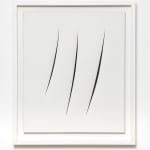
Lucio Fontana Argentine-Italian, 1899-1968
Concetto Spaziale, Attese, 1961
Waterpaint on canvas
55 x 46 cm. (21 5/8 x 18 1/8 in.)
Copyright The Artist
Further images
Lucio Fontana’s Concetto Spaziale, Attese (1961) stands as a profound testament to the artist’s revolutionary Spatialist vision. With its three iconic tagli (‘cuts’), the work embodies Fontana’s enduring quest to...
Lucio Fontana’s Concetto Spaziale, Attese (1961) stands as a profound testament to the artist’s revolutionary Spatialist vision. With its three iconic tagli (‘cuts’), the work embodies Fontana’s enduring quest to transcend the two-dimensional confines of painting and open art to the infinite realm of space and time. Emerging from his groundbreaking Manifesto Blanco, first articulated in Argentina in the wake of the Second World War, Fontana’s Spatialist philosophy sought to merge art with the pulsating dynamism of the modern era – an epoch defined by technological breakthroughs and cosmic exploration.
In Concetto Spaziale, Attese, the pristine white canvas is slashed with three decisive incisions, their rhythmic placement and sharp clarity transforming the painting into an object of profound contemplation. These cuts, simultaneously violent and meditative, evoke the mysteries of the cosmos, as if Fontana had torn through the veil separating human perception from the infinite unknown. His gesture resounds with the awe and curiosity of the Space Age – a period when humanity’s gaze shifted irrevocably towards the stars.
In the late 1940s, Fontana began his series of buchi (‘holes’), works that punctured the surface of canvas or ceramic to challenge its sanctity. By the late 1950s, he advanced this dialogue through the tagli series, introducing an unmistakable gestural dynamism. The cuts, as seen in Concetto Spaziale, Attese, carry a temporal quality: they are records of a moment of action, preserving the tension, energy, and precision of their creation.
Fontana’s genius lies in his ability to distil these epochal shifts into simple, resonant acts. As he once explained, the tagli are “the Expectation of something that must follow,” a concept encapsulated in the work’s title, Attese (‘Waiting’). Each incision becomes an aperture not only to physical space but to metaphysical realms, reflecting the artist’s belief that art must evolve alongside humanity’s expanding understanding of the universe.
In this way, Fontana’s Concetto Spaziale, Attese is not merely an object but a moment of becoming – a crystallisation of movement, energy, and anticipation. The clean, unbroken lines of the cuts reveal the tension of their creation: the meticulous preparation, the charged moment of decision, and the liberating act of their execution. These cuts, as Fontana’s hand guides them, articulate a poetry of rupture, where destruction births creation and the artwork transcends its materiality to engage directly with time and space itself.
In Concetto Spaziale, Attese, the pristine white canvas is slashed with three decisive incisions, their rhythmic placement and sharp clarity transforming the painting into an object of profound contemplation. These cuts, simultaneously violent and meditative, evoke the mysteries of the cosmos, as if Fontana had torn through the veil separating human perception from the infinite unknown. His gesture resounds with the awe and curiosity of the Space Age – a period when humanity’s gaze shifted irrevocably towards the stars.
In the late 1940s, Fontana began his series of buchi (‘holes’), works that punctured the surface of canvas or ceramic to challenge its sanctity. By the late 1950s, he advanced this dialogue through the tagli series, introducing an unmistakable gestural dynamism. The cuts, as seen in Concetto Spaziale, Attese, carry a temporal quality: they are records of a moment of action, preserving the tension, energy, and precision of their creation.
Fontana’s genius lies in his ability to distil these epochal shifts into simple, resonant acts. As he once explained, the tagli are “the Expectation of something that must follow,” a concept encapsulated in the work’s title, Attese (‘Waiting’). Each incision becomes an aperture not only to physical space but to metaphysical realms, reflecting the artist’s belief that art must evolve alongside humanity’s expanding understanding of the universe.
In this way, Fontana’s Concetto Spaziale, Attese is not merely an object but a moment of becoming – a crystallisation of movement, energy, and anticipation. The clean, unbroken lines of the cuts reveal the tension of their creation: the meticulous preparation, the charged moment of decision, and the liberating act of their execution. These cuts, as Fontana’s hand guides them, articulate a poetry of rupture, where destruction births creation and the artwork transcends its materiality to engage directly with time and space itself.
